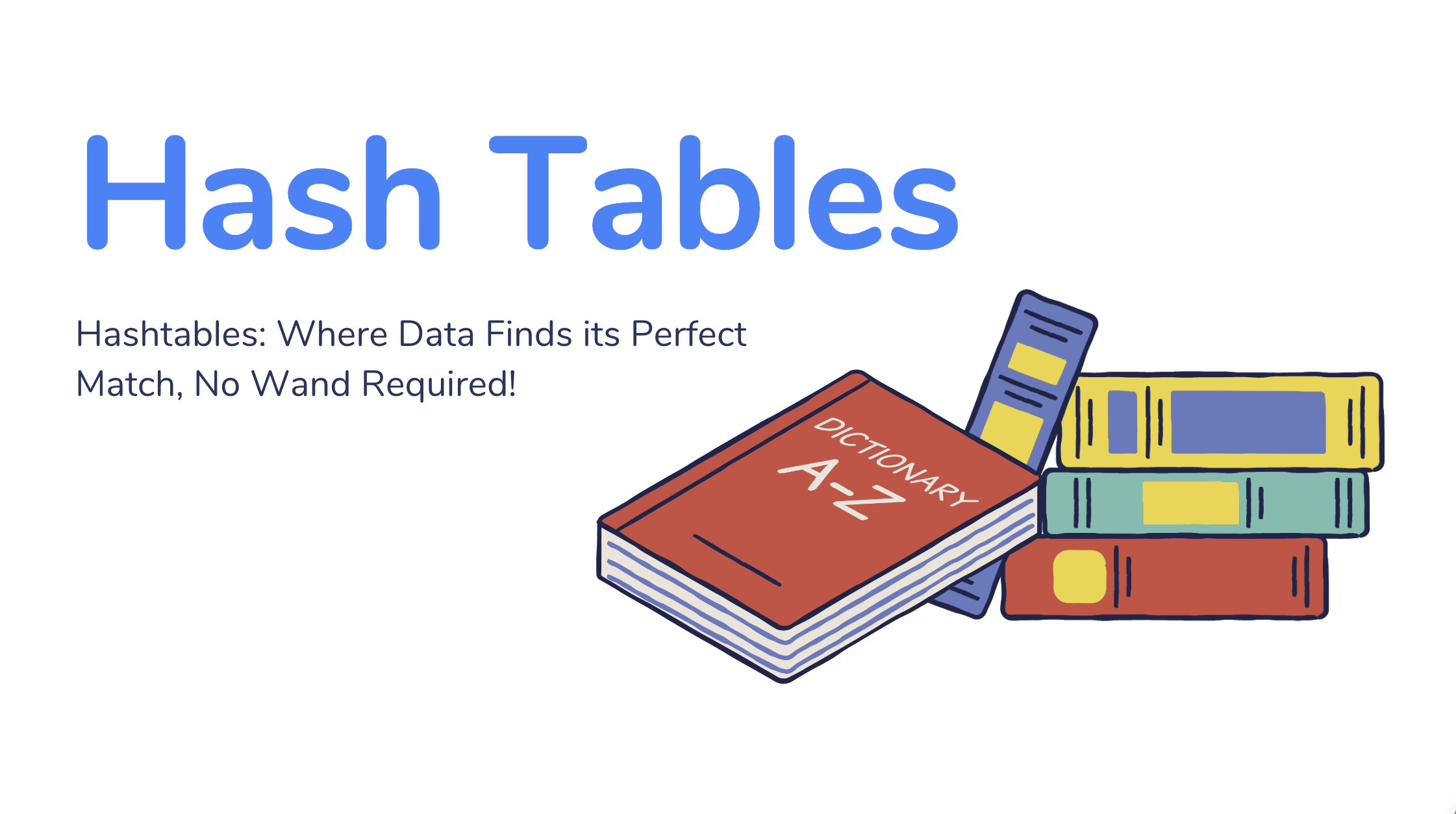Hash Tables
 Shahima Firoz khan.
Shahima Firoz khan.
Introduction and concepts
A hash table, also known as a hash map, is a data structure that enables efficient storage and retrieval of data through a hash function. It organizes data in key-value pairs, where each key is unique and associated with a corresponding value.
Key-Value Storage: Hash tables store data as unique key-value pairs for efficient retrieval.
Hash Function: A hash function maps keys to array indices for storage and retrieval.
Fast Retrieval: Hash tables quickly retrieve values based on keys (O(1) average time complexity).
Unique Keys: Hash tables require keys to be unique to ensure proper functioning. If two keys are the same, the value associated with the latest key will overwrite the previous value.
Collision Handling: Collisions, when two keys map to the same index, are handled using techniques like chaining or open addressing.
Efficiency Trade-Off: Hash tables balance memory usage and retrieval speed based on the array size and collision resolution strategy.
Unordered Structure: Hash tables do not guarantee a specific order for stored keys or values.
Dynamic Resizing: Hash tables can dynamically resize to accommodate changes in the number of elements.
Memory Overhead: Hash tables require additional memory for indices and collision resolution structures.
Animation for Hash Tables.
Question: "But you might be wondering, this hash function, doesn't it slow things down?"
Answer: You might have the concern that the hash function, which is somewhat like a black box, could potentially slow down the operations. However, the design of hash tables considers this to ensure optimal performance.
Underneath the hood, hash tables utilize optimized hashing functions that are specifically designed to be fast. These functions are implemented within various programming languages and frameworks, ensuring efficient execution.
It is worth noting that there are certain hash functions, such as SHA-256, which are intentionally slower. However, such complex hash functions are commonly used in specialized areas like cryptography, where the objective is to deliberately increase the time required for hashing.
In the context of hash tables, the chosen hash function is typically one that provides fast execution. The time complexity of hash table operations is commonly assumed to be O(1), denoting constant time complexity and ensuring rapid performance.
Hence, although the inner workings of the hash function might seem like a mysterious black box, the implementation of optimized and fast hash functions allows hash tables to deliver efficient and speedy operations.
Hash Operations
| Operation | Time Complexity |
| Insertion | O(1) |
| Deletion | O(1) |
| Retrieval | O(1) |
| Update | O(1) |
| Resizing | O(n) |
| Collision Resolution | Varies (typically O(1) with a good hash function and load factor) |
Collision
In this example, we are inserting names and phone numbers into a hash table. Initially, John Smith is hashed to address space 152 and stored along with its corresponding value. We continue adding names like Lisa Smith, Sam Doe, and Sandra Oh, but when we reach Sandra Dee, a collision occurs because it shares the same address space as John Smith. To handle collisions, a new data structure called linked lists is introduced. With hash tables, collisions are unavoidable as the data grows, and it can slow down accessing and inserting information.
Collisions in a hash table can lead to slower reading and writing, typically with a time complexity of O(N/K).

There are several methods for collision resolution in hash tables:
Separate Chaining: This method involves maintaining a linked list or another data structure at each index of the hash table. Colliding keys are stored in separate buckets or nodes within the same index. This allows multiple keys to coexist at the same location.
Open Addressing: With open addressing, all key-value pairs are stored directly in the hash table itself. If a collision occurs, the algorithm probes for alternative (usually nearby) locations until an empty slot is found. This method requires a careful selection of probing strategies, such as linear probing, quadratic probing, or double hashing.
Robin Hood Hashing: In this method, colliding elements are placed in the same index, but an additional attribute called "distance" is used to keep track of how far each element has travelled from its original hashed position. During insertion, elements with shorter distances are shifted forward, making room for new elements and reducing clustering.
Cuckoo Hashing: Cuckoo hashing uses multiple hash functions and multiple hash tables. Each key is hashed by different functions and placed in their respective hash tables. If a collision occurs, the algorithm checks the alternative hash table and swaps the keys if necessary. This process continues until all keys find their places or a predefined number of displacements is reached.
These are just a few examples of collision resolution methods commonly used in hash tables. The choice of method depends on factors such as expected data distribution, memory constraints, and performance requirements. Each method has its own trade-offs in terms of time complexity, memory usage, and ease of implementation.
"Hash tables are implemented differently in various programming languages, allowing key-value pairs of any data type. Objects in JavaScript have limitations on key types, but with ES6, maps and sets were introduced. Maps allow any data type as keys and maintain insertion order, while sets only store keys without values. These prebuilt data structures are variations of hash tables, providing different functionalities."
Implementing Hash Tables
Subscribe to my newsletter
Read articles from Shahima Firoz khan. directly inside your inbox. Subscribe to the newsletter, and don't miss out.
Written by

Shahima Firoz khan.
Shahima Firoz khan.
Hey there, I'm Shahima, a humble professional with a penchant for analyzing details and a love for logical reasoning. Currently pursuing my computer engineering major in India, I'm also diving deep into the fascinating realm of data science. Consider Hashnode my personal virtual diary, where I jot down thoughts and discoveries in the coding universe. Now, here's a little secret: I have a borderline obsession with data structures and algorithms, but let's keep that between us. When it comes to web development, I've got it covered like a perfectly nested div. In fact, I even had the honour of being crowned the victorious champion at the prestigious Smart India Hackathon 2022, where my problem-solving skills were put to the ultimate test. Oh, and did I mention that I miraculously clinched an international rank of 260 in the English Olympiad? Turns out coding and grammar go hand in hand! As I embark on this exciting journey, I'm on the lookout for opportunities that allow me to unleash my data analysis prowess, decipher intricate patterns, and create models that can predict the future (well, almost). So, if you're seeking a dynamic and driven individual to join your team, consider me your debugging partner. Together, let's revolutionize the world of technology and make it bug-free! Ready to embark on this coding adventure?

